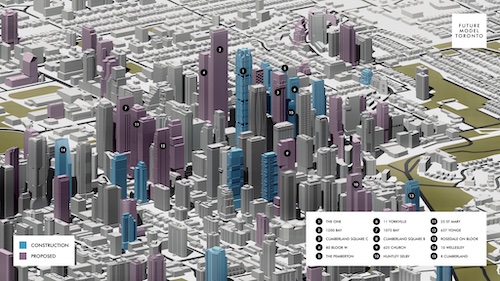The fastest growing skyline in North America isn't where you might guess.


|
Toronto has more construction cranes in operation (225 earlier this year) than any city in North America, and it has for more than a decade. More than 100 buildings over 100 meters are under construction and 300 more have been proposed.
Skyline visualization courtesy Stephen Velasco's Future Model Toronto
|
Since 2009, no city in the United States — the birthplace of the skyscraper — has added more tall buildings to its skyline than Toronto. And nowhere is a local union working harder to wring market share growth from a boom than Toronto Local 353.
Since 2005, the Greater Toronto area has added 77 buildings over 100 meters (about 330 feet), and more than 100 are currently under construction. The next closest is New York City with only 75. Incredibly, nearly 300 more skyscrapers have been proposed in Greater Toronto.
But the really dramatic changes are in the buildings that are even taller. Between 1978 and 2004, only five 150-meter-plus buildings were completed in Toronto, according to the Council on Tall Buildings.
Then, seven were finished in 2019 alone. Six more opened in 2020. And eight more were completed last year. By the end of this year, a remarkable 16 more are expected, projects that will completely change Toronto's skyline forever.
There are 10 projects, either proposed or underway, that will top out above 300 meters, including Canada's first supertall, the 336-meter, IBEW-built The One.

|
The M-City complex in Mississauga is one of multiple multi-tower developments Local 353 members are building in the Greater Toronto area.
Credit: Urban Capital
|
Like The One, nearly all the new construction, more than 90%, is either pure residential or mixed-use.
"The younger generation looks at the world differently. They're more laid back; their free time is more important than anything else. They don't want to commute or mow the lawn. A condo is easy to lock up and head out. And to head out on foot, you need to be downtown," said Local 353 Business Manager Lee Caprio.
As every construction worker quickly learns, construction is a cyclical industry. You do as much work as possible in the highs and consolidate during the lows.
The same is true for local unions. Local 353 has been at virtually full employment for nearly a decade, but market share has not kept pace. Nonunion contractors have been growing, and Caprio, who has been in office for just over a year, is working with newly elected First District International Vice President Russ Shewchuk and Construction Council of Ontario Executive Secretary-Treasurer James Barry to stop the slide and to turn an unprecedented boom into a just-as-unprecedented reclamation of market share.
"I want to wave the 'Start your engines flag' and say 'Let's go.' We have the expertise and the manpower. We are open for business for all contractors coast-to-coast," Shewchuk said. "Our contractors should not be afraid to bid on any job. We will work with clients and owners to make the numbers work."
Top Down, Bottom Up and Bid on Everything

|
Original plans for The One, under construction, top, were changed to add dozens of meters after another IBEW-built project, the Concord Sky, above, threatened its claim to the tallest building in Canada.
Credit: Concord Adex, Inc.
|
Historically, Local 353 has dominated industrial, manufacturing and commercial building construction.
While the pandemic, supply chain constraints and rising fears of a recession have throttled both new commercial and building renovation work, it has barely slowed the decade-old condo boom.
Buildings go up when they can't spread out. Huge areas of the Greater Toronto Area are zoned for single-family homes only, and protected farmland rings the city where near-in suburbs and Lake Ontario don't.
Because Toronto's high-density corridors like Downtown Core, Yonge and Eglinton, The Golden Mile, Don Mills and Eglinton and North York Centre allow greater building heights, they are getting denser by the day.
Since 2015, there have been more tower cranes in Toronto than any other city in North America. At peak there were more than 200; today there are still more than 125, far more than second-place Miami, according to the RLB Crane Index, which tracks construction cranes in the 14 most important North American metropolitan areas.
Unfortunately, Caprio said, nonunion contractors were allowed to grow, first in the smaller, lower-cost and lower-margin residential construction market, and within the last few years, into downtown.
"I was just at the International Convention in Chicago, and I wish we were like them where every crane was union, but we just aren't," he said. "But that is the goal we have set."
The struggle to push up market share is largest outside the downtown core, Caprio said, where there were no buildings over 20 stories when he first started out.
"Now there are 75 approved in Vaughan alone," Caprio said of the suburban center a half-hour north of downtown Toronto. Vaughan's population has doubled in the last two decades, making it the fastest-growing municipality in Canada in those years. It's a similar story, Caprio said, east from downtown along Highway 401 from Scarborough to Oshawa.

|
Inner suburbs that had low union density are also booming, and Local 353 is winning huge projects like Festival Condos in Vaughan.
Credit: Menkes Development
|
The largest nonunion high-rise contractor has quadrupled in size since 2010, Caprio said, and the largest commercial contractor has tripled in size over that same time frame.
Throughout the pandemic, he said, worker-safety initiatives implemented by provincial authorities slowed production but kept his members safe. But they were regularly ignored by nonunion contractors. Limits on the number allowed in skip hoists and mandatory COVID tracking slowed down work but kept people safe, and union contractors adhered to the rules.
"Out of a seven-hour day, they got only six hours of production just due to people getting in and out of the jobsite. Nonunion contractors didn't follow those rules, and the Ministry of Labour couldn't have looked into it. There weren't enough inspectors. It punished people doing the right thing," he said. "It should have been the best time in our history, but we kept getting held back."
The stubborn stall of market share created a desire across the membership to try new things.
"There has been a real embrace of change in Ontario and across the First District," Barry said.
And, both Caprio and Barry said, while organizing is never easy, it is never easier than in a boom.
"Ten of the 11 Ontario locals have travelers right now. The opportune time to call owners is when they are struggling to staff a job," Barry said.
Market share, though, Barry said, only grows out of developing that relationship and creatively working with them to make up the price difference for a union workforce.
For Barry, investment in education is the key long-term differentiator for the IBEW in the province.
Foreperson training, for example, is a vastly underrated way to improve bottom lines and a crucial IBEW advantage they have worked to expand with the Electrical Training Alliance.
Barry has also, for the first time in recent memory, won funding from the Conservative provincial government to train low-voltage workers, a sector that has been almost entirely dominated by nonunion contractors.
"We priced ourselves out of the work, if I'm honest," he said, citing jobs that went partially to the IBEW but where security, communications and internet wiring get subbed out.
The improved relationships with the government have also been crucial when bids have been let for the billions of dollars in infrastructure projects in the province.
"Sound practices translate into market share," he said. "When we work collaboratively with government, it is starting to bear fruit."
It isn't all education and phone calls with owners and politicians though.
The hard work is being matched, he said, with organizing. There are 10 provincial organizers focusing solely on low voltage. Eighteen months ago, there were none.
But even there, things are being done differently.
Caprio said they aren't interested in returning to the old days of "Turn 'Em or Burn 'Em" — where if a top-down campaign was rejected, union reps would use any tool in the bag to disrupt a nonunion contractor. It may have felt good, he said, but it often permanently alienated what could have been future partners.
And it isn't necessary.
For example, this year, Local 353 negotiated a $3/hr one-shot raise, effective May 1. Caprio had a bunch of rate sheets printed up and they have been leafletting nonunion jobsites. "We told them, 'IBEW got a $3 raise. Make sure you do, too,'" Caprio said.
The good news is that the strategy is working.
After a Local 353 signatory contractor won a bid for part of a six-building development called The Well, the major nonunion contractor who'd been awarded another part of the job refused to work onsite with the IBEW, Caprio said.
"The reason the base building and condo side of it is all our work is that this big nonunion company didn't want to work alongside us. They knew we would strip them so fast," Caprio said. "Their workers would walk across the imaginary line between our work and join us."
The difference is not so pronounced on the site with smaller nonunion contractors doing tenant work, but at least for the major projects, the results are already showing. "We have organized 22 shops in the last 18 months," he said.
Recent inflation and the clear wage gap between IBEW and nonunion electricians has been a driving factor, said Local 353 Membership Development Representative Tony Chiappetta. "The nonunion side has never been more receptive to our message, and we're working hard to reach all of them."
The Wins
Even though there is opportunity for growth, there are plenty of current victories to celebrate, prestige projects built with IBEW hands.
The biggest is The One, which will be the tallest building in Canada, between 300 and 340 meters tall. Developers recently filed a request to allow additional height when it looked like another development might steal its "tallest building in the city" crown.
When complete, The One will finally take the title from First Canadian Place, which has been Canada's tallest building since 1976.
Signatory contractor OZZ Electric, one of Local 353's largest, won the bid for the project along with four of the other nine largest projects in the city: the 299-meter Concord Sky, 260-meter M3 at M City, 240-meter 160 Front Street West and the 231-meter Concord Canada House 1.
Local 353 members will also be working on the 243-meter CIBC Square II office building, the six-tower Transit City Condos, Festival Towers and Mobilio Condos projects, Chiappetta said.
"Organizing is a battle every day," Chiappetta said. "The volume of work in the Greater Toronto Area has given rise to opportunities for start-up companies like never before. We are holding our own in 353 — work hours annually have been consistent — but the nonunion side is growing at a faster clip presently and it is a threat.
"There is so much room to grow and we want it all," he said. "It's a harsh reality that the nonunion construction industry in the Toronto area is bigger than most locals in North America. We have to stay sharp, stay focused and be more diligent than ever when it comes to organizing."
Caprio echoed the call for even greater effort. The big projects his members are working on now are just a starting line, he said, but the opportunities for growth are endless.
It's easier to recruit new members from the nonunion side when you have work and can promise a higher wage, after all. The trick, he said, is to be in such a strong position in the market that when things turn — as they always do — that you're strong enough to ride it out.
"It's simple: We can't afford to let them get bigger," he said. "We erode their work over the next year. Then we suffocate the nonunion in any coming recession."
That is what it takes to achieve permanent growth, Barry said.
"Market share takes decades because it isn't about organizing, it's about how you keep it. That is the fundamental and critical piece," he said. "Stats are great all and all, but it all comes down to relationships."